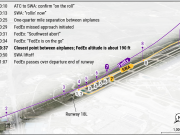The Transportation Safety Board of Canada (TSB) has criticized the air traffic control (ATC) practice of allowing aircraft and ground vehicles to cross seldom-used runways without prior coordination among controllers, citing the practice for contributing to a Dec. 2, 2016, serious runway incursion at Calgary International Airport in Alberta. In a report issued Monday, the TSB said that the incursion occurred after strong westerly winds prompted the airport to stop using parallel north/south runways in favor of Runway 29, with a west-northwest orientation.
An Air Canada Airbus A320 was cleared for takeoff on Runway 29 and, during the takeoff roll, the crew saw a Sunwest Aviation Swearingen SA226 taxiing across the runway at a taxiway intersection. Because the SA226 was more than halfway across the runway, the A320 crew continued their takeoff and passed the intersection only seconds after the smaller airplane had cleared the runway.
“The ground controller, who was simultaneously overseeing the movement of two other aircraft, inadvertently applied the usual practice of clearing aircraft to cross Runway 29 without coordinating with the tower controller,” the report said.
The TSB noted that the risk of runway collisions is included in the board’s Watchlist of safety issues in need of attention.
In 2016, there were a total of 411 runway incursions in Canada, 21 of which were deemed as “serious,” according to TSB data. Serious runway incursions are defined by the International Civil Aviation Organization as Class A incursions, in which a collision was narrowly avoided, or Class B incursions, in which there was a significant potential for collision. The TSB said this occurrence was a class B event.

